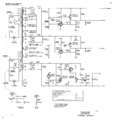516: Difference between revisions
No edit summary |
No edit summary |
||
| Line 52: | Line 52: | ||
File:Tek 516 front right.jpg|Right front, sweep rate switch | File:Tek 516 front right.jpg|Right front, sweep rate switch | ||
File:Tek_516_hvps1.jpg|HV power supply | File:Tek_516_hvps1.jpg|HV power supply | ||
File:Tek_516_left_front_top.jpg| | File:Tek_516_left_front_top.jpg|Right front | ||
File:Tek 516 left rear.jpg|Left rear | File:Tek 516 left rear.jpg|Left rear | ||
File:Tek 516 left top.jpg|Left top | File:Tek 516 left top.jpg|Left top | ||
Revision as of 08:57, 14 May 2013
The Tektronix Type 516 is a monolithic 15MHz dual-trace oscilloscope introduced in 1960. It contains no transistors. The 516 is essentially a dual trace version of the 515. The main difference between the 515 and 516 is the front end. The 515 uses a conventional rotary switch for the input attenuator while the 516 uses turret attenuators. There are also some differences in the vertical amplifier circuitry. The 515 uses a 6AU6 pentode at the front end. The 516 uses a 6DJ8 dual triode at the front end, and in many other places throughout the instrument.
In a 516, the delay line directly drives the vertical deflection plates of the CRT.
The standard CRT is the T55 with P31 phosphor. It has a post-deflection acceleration voltage of +2335V. The CRT cathode runs at -1675V. The HV power supply uses three 5642 rectifier tubes:
- V822 for the CRT cathode voltage
- V832 for the CRT control grid voltage
- V842 for the post-deflection voltage
The LV power supply is typical of 1960's Tek scopes. It provides:
- +400V unregulated
- +300V regulated, using one triode of a 6080 as the output tube
- +100V regulated, using one triode of a 6080 as the output tube
- -150V regulated, using a 6AU5 tube as the output tube
The reference for the LV supply is a 5651 which produces a -87V reference, which controls the -150V supply. The -150V supply is used as the reference for the +100V and +300V supplies.
-
-
-
-
-
turret attenuator
-
HV power supply schematic
-
LV power supply schematic
-
Vertical input amplifier schematic
-
Vertical output schematic
-
Trigger schematic
-
Timebase schematic
-
Horizontal amplifier schematic
-
Bottom, toward front
-
Bottom, toward rear
-
Attenuators and front-end
-
Right front, sweep rate switch
-
HV power supply
-
Right front
-
Left rear
-
Left top
-
CRT neck pins
-
Rear right, transformer, filter caps, fan
-
Right top
-
Rear























